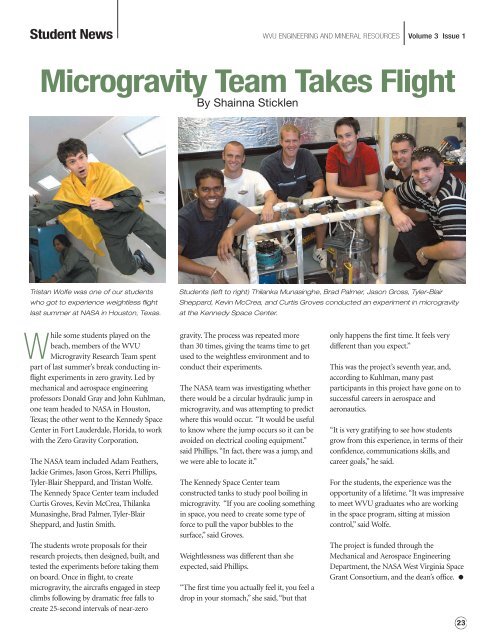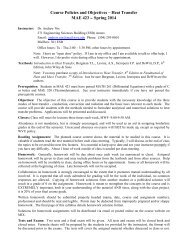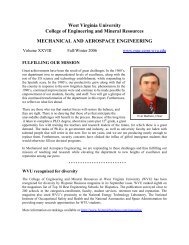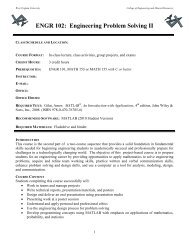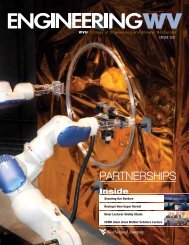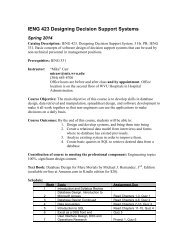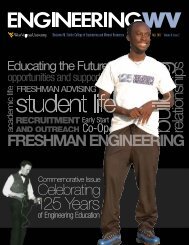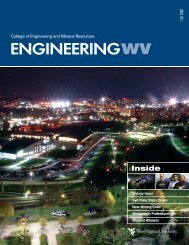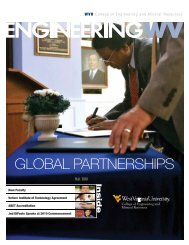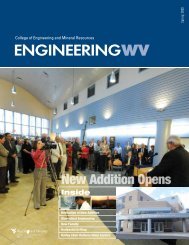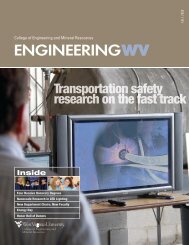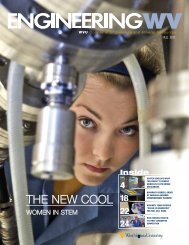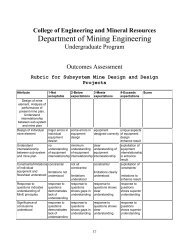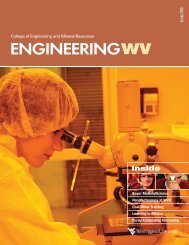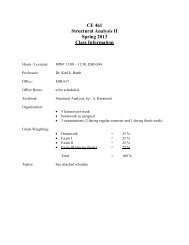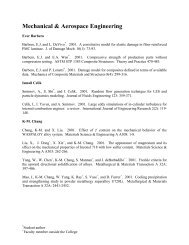70931, page 1-35 @ Normalize - WVU College of Engineering and ...
70931, page 1-35 @ Normalize - WVU College of Engineering and ...
70931, page 1-35 @ Normalize - WVU College of Engineering and ...
Create successful ePaper yourself
Turn your PDF publications into a flip-book with our unique Google optimized e-Paper software.
Student News<br />
<strong>WVU</strong> ENGINEERING AND MINERAL RESOURCES Volume 3 Issue 1<br />
Microgravity Team Takes Flight<br />
By Shainna Sticklen<br />
Tristan Wolfe was one <strong>of</strong> our students<br />
who got to experience weightless flight<br />
last summer at NASA in Houston, Texas.<br />
Students (left to right) Thilanka Munasinghe, Brad Palmer, Jason Gross, Tyler-Blair<br />
Sheppard, Kevin McCrea, <strong>and</strong> Curtis Groves conducted an experiment in microgravity<br />
at the Kennedy Space Center.<br />
While some students played on the<br />
beach, members <strong>of</strong> the <strong>WVU</strong><br />
Microgravity Research Team spent<br />
part <strong>of</strong> last summer’s break conducting inflight<br />
experiments in zero gravity. Led by<br />
mechanical <strong>and</strong> aerospace engineering<br />
pr<strong>of</strong>essors Donald Gray <strong>and</strong> John Kuhlman,<br />
one team headed to NASA in Houston,<br />
Texas; the other went to the Kennedy Space<br />
Center in Fort Lauderdale, Florida, to work<br />
with the Zero Gravity Corporation.<br />
The NASA team included Adam Feathers,<br />
Jackie Grimes, Jason Gross, Kerri Phillips,<br />
Tyler-Blair Sheppard, <strong>and</strong> Tristan Wolfe.<br />
The Kennedy Space Center team included<br />
Curtis Groves, Kevin McCrea, Thilanka<br />
Munasinghe, Brad Palmer, Tyler-Blair<br />
Sheppard, <strong>and</strong> Justin Smith.<br />
The students wrote proposals for their<br />
research projects, then designed, built, <strong>and</strong><br />
tested the experiments before taking them<br />
on board. Once in flight, to create<br />
microgravity, the aircrafts engaged in steep<br />
climbs following by dramatic free falls to<br />
create 25-second intervals <strong>of</strong> near-zero<br />
gravity. The process was repeated more<br />
than 30 times, giving the teams time to get<br />
used to the weightless environment <strong>and</strong> to<br />
conduct their experiments.<br />
The NASA team was investigating whether<br />
there would be a circular hydraulic jump in<br />
microgravity, <strong>and</strong> was attempting to predict<br />
where this would occur. “It would be useful<br />
to know where the jump occurs so it can be<br />
avoided on electrical cooling equipment.”<br />
said Phillips. “In fact, there was a jump, <strong>and</strong><br />
we were able to locate it.”<br />
The Kennedy Space Center team<br />
constructed tanks to study pool boiling in<br />
microgravity. “If you are cooling something<br />
in space, you need to create some type <strong>of</strong><br />
force to pull the vapor bubbles to the<br />
surface,” said Groves.<br />
Weightlessness was different than she<br />
expected, said Phillips.<br />
“The first time you actually feel it, you feel a<br />
drop in your stomach,” she said, “but that<br />
only happens the first time. It feels very<br />
different than you expect.”<br />
This was the project’s seventh year, <strong>and</strong>,<br />
according to Kuhlman, many past<br />
participants in this project have gone on to<br />
successful careers in aerospace <strong>and</strong><br />
aeronautics.<br />
“It is very gratifying to see how students<br />
grow from this experience, in terms <strong>of</strong> their<br />
confidence, communications skills, <strong>and</strong><br />
career goals,” he said.<br />
For the students, the experience was the<br />
opportunity <strong>of</strong> a lifetime. “It was impressive<br />
to meet <strong>WVU</strong> graduates who are working<br />
in the space program, sitting at mission<br />
control,” said Wolfe.<br />
The project is funded through the<br />
Mechanical <strong>and</strong> Aerospace <strong>Engineering</strong><br />
Department, the NASA West Virginia Space<br />
Grant Consortium, <strong>and</strong> the dean’s <strong>of</strong>fice.<br />
23


